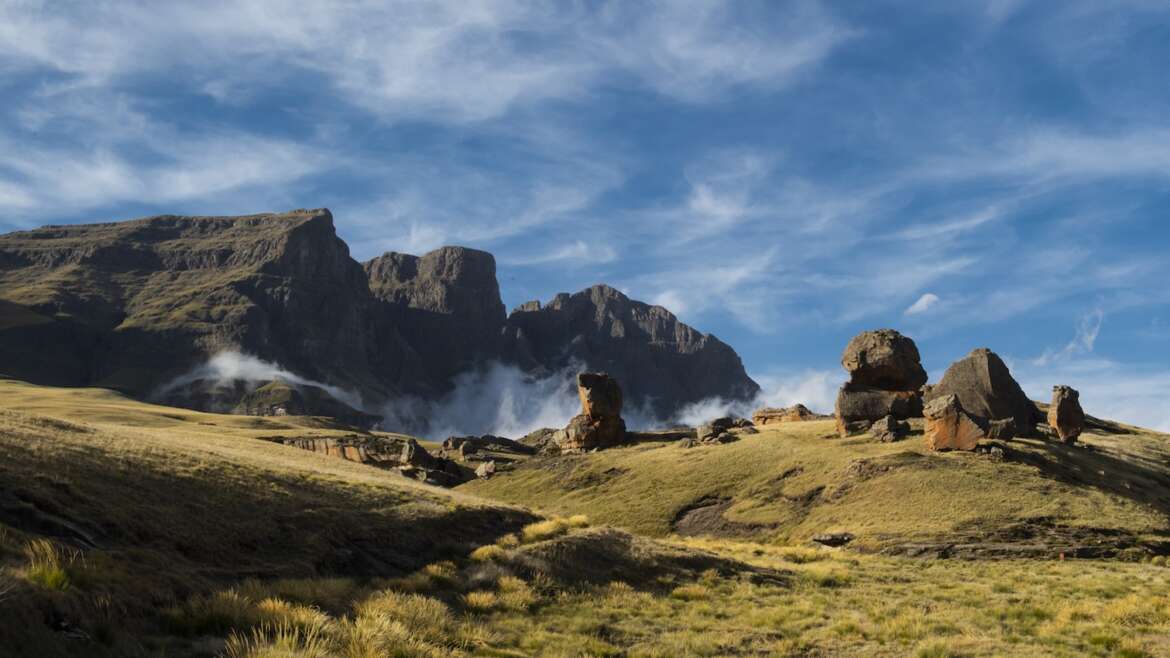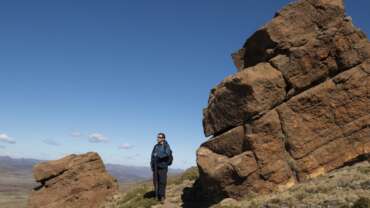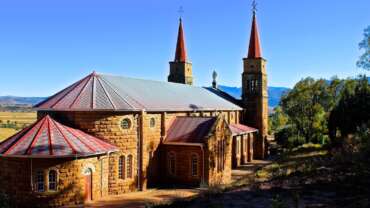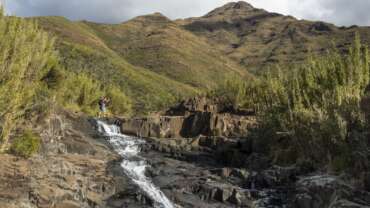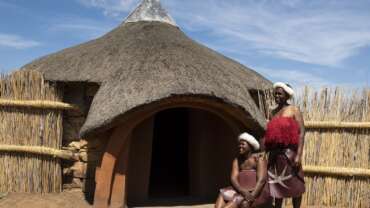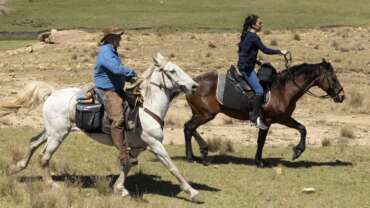National Parks & Reserves in Lesotho
Lesotho contains two national parks. Both are primarily of interest for the opportunity to hike or do a horseback trek in a scenic highland setting, but the two are very different in terms of the landscapes and ecologies they protect.
Lesotho’s oldest and largest protected area, Sehlabathebe National Park forms part of the cross-border Maloti-Drakensberg World Heritage Site as inscribed by UNESCO. One of the region’s most isolated and dramatic national parks, it protects a panorama of rolling grassland studded with immense rock arches, sandstone caves, waterfalls and rock pools, all set below an imposing formation known as the Devil’s Knuckles. Other attractions include colourful wildflowers, large mammals such as grey rhebok, baboon and black-backed jackal, trout fishing in the streams, typical Afromontane birds including Cape vulture and Drakensberg rockjumper, and an incredible 65 prehistoric rock art sites.
Far more accessible than Sehlabathebe, Ts’ehlanyane National Park stands in the rugged Maluti Mountains northeast of Maseru. An important stronghold for the endemic bamboo species with which it shares its Sesotho name, Ts’ehlanyane also supports some of the last remaining indigenous forest in Lesotho, dominated by the evergreen Ouhout tree. The park is bisected by four montane streams punctuated by some spectacular waterfalls and lovely natural swimming pools. It is one of the last places in Lesotho roamed by the majestic eland antelope, and it also supports a diverse birdlife including bush blackcap and malachite sunbird.
There are a few other notable natural areas in Lesotho. Bokong Nature Reserve is famed for its Alpine flora and fauna, and a spectacular waterfall that often freezes solid in winter. The small but very rewarding Katse Botanical Garden has much to offer keen birders as well as botanists. Another great birding site, the remote and little-visited Lake Letsie is a Ramsar wetland and important catchment area protected in the Letseng-la-Letsie Nature Reserve.
Bokong Nature Reserve
Bisected by the surfaced A25 as it runs between Leribe and Katse Dam, lofty Bokong is a small but very scenic and hiker-friendly reserve spanning altitudes of 2,800 to 3,200 metres. It is best-known as the site of the attractive Lepaqoa Falls, which tumbles horseshoe-like over a 60-metre cliff, and often freezes in winter to form a column of solid ice.
Bokong Nature Reserve is accessed via the Mafika Lisiu Pass, whose name alludes to a prominent rock formation said locally to resemble a maize bag. The pass reaches its misty windswept apex at an altitude of 3,090 metres, where a short side road leads to an impressive viewpoint over the relatively low-lying foothills to the west.
A short distance past the summit of Mafika Lisiu, Bokong Nature Reserve’s attractive clifftop Visitors’ Centre overlooks the green valley carved by the Lepaqoa River and hosts an informative interpretative display. The centre also offers a distant view to Lepaqoa Falls, but for better views it is worth following the flattish 1.5km footpath that leads across a boulder-strewn highland meadow to a viewpoint directly above and opposite the waterfall.
The footpath to the waterfall passes through highland bogs and fends that protect several endemic plan species and play an important ecological role sponging up rainwater in the wet season. During the drier winter months, this water is gradually released into the many montane streams that rise in the reserve, reinforcing its importance as a watershed.
The grey rhebok, a medium-sized antelope endemic to southern Africa, is often seen running through the montane meadows of Bokong and easily recognised by the conspicuous fluffy white tail it holds aloft when in flight. The endangered Cape vulture breeds in the cliffs opposite the Visitor’s Centre. Other endemic birds likely to be seen include the handsome Drakensberg rockjumper, vociferous grey-winged Francolin, and peculiar ground woodpecker. A conspicuous seasonally flowering plant is the red-hot poker (Kniphofia spp), which often grows in fiery orange and yellow clumps close to streams.
Although most visitors stick to the short trail between the Visitors’ Centre and the viewpoint to Lepaqoa Falls, hiking is permitted anywhere in the reserve. Bokong is also the starting point for a stunning two- to three-day 32km hike to Ts’ehlanyane National Park via an alpine plateau sometimes referred to as the Roof of Africa.
Lake Letsie
The largest natural freshwater body in Lesotho, remote and little-visited Lake Letsie is a true off-the-beaten-track scenic gem that will prove particularly rewarding to birdwatchers.
A gorgeous Alpine lake set an at an altitude of above 3,000m, Letsie occupies a grassy 800ha valley enclosed surrounded by rocky heather-clad slopes that bloom bright yellow in spring. Not only is it the kingdom’s only Ramsar protected wetland, but it also forms the centrepiece of the Letseng-la-Letsie Nature Reserve. It is an important catchment area that filters the source of the Quthing River, a major tributary of the Senqu (Orange).
Birders are in for a treat. The endangered Cape vulture soars overhead, occasionally joined by the even rarer bearded vulture, and the likes of Verreaux’s eagle, jackal buzzard and lesser kestrel. The inundated grassland around the lake is a favoured haunt of blue crane, southern bald ibis and black harrier, all of which are regional endemics, and it is also visited seasonally by European stork and wattled crane. The lake’s shallows are a magnet for waterfowl and waders, including the lovely black-winged stilt and pied avocet, while the surrounding slopes support such highland specials as Drakensberg rockjumper, ground woodpecker, yellow-breasted pipit and Drakensberg siskin. Mammals are scarcer, but you might well see the endearing rock hyrax and Sloggett’s ice rat on rocky outcrops.
An added attraction of Lake Letsie is the spectacular but occasionally challenging dirt road that connects it to Mount Moorosi via the Makoae River. For keen walkers, an excellent add-on to Lake Letsie is the four-hour round hike to the Majoana Mabedi Falls, which ranks among the most spectacular waterfalls in Lesotho, its twin streams plunging more than 100m into a sheer-sided ravine.
Liphofung Nature Reserve
Lesotho’s smallest nature reserve protects a dramatic and atmospheric rock overhang known for its historical association with the 19th-century King Moshoeshoe I and for housing a collection of rock paintings attributed to the San (Bushmen) hunter-gatherers who inhabited the region in prehistoric times.
Liphofung (literally Place of the Eland) is named for the paintings of Africa’s largest antelope left behind on its walls by the San hunter-gatherers who dwelt and performed shamanic rituals in the deep overhang for a period of around 5,000. Other rock art at the site includes depictions of people hunting, stick-fighting and participating in a rainmaking ceremony. Though the paintings are more faded that at other sites in Lesotho such as Ha Baroana and Tsatsane, they are accompanied by excellent explanatory panels that show what they would have looked like in their prime and also place then in a cultural context.
Liphofung’s other main claim to fame is that the future King Moshoeshoe I, founder of the Sotho Kingdom, sheltered in the overhang when he travelled to the area as a young man, and then used it as a natural sanatorium for injured soldiers during a battle undertaken in 1840.
A small Visitors’ Centre incorporating displays about traditional Basotho culture, King Moshoeshoe and San rock art has been developed at the site. From here, it is just a five-minute walk to the overhang along a steep but well-maintained footpath.
Sehlabathebe National Park
Established in 1970 as Lesotho’s first national park, the fabulously scenic and remote Sehlabathebe protects 65 square kilometres of rolling boulder-studded grassland set below the uKhahlamba-Drakensberg escarpment as it runs along the border with South Africa.
Set at an average altitude of 2,400 metres, Sehlabathebe – literally ‘Shield of the Plateau’ – is one of the most isolated and dramatic national parks anywhere in southern Africa. Its international importance was recognised in 2008 when UNESCO incorporated it into the cross-border Maloti-Drakensberg World Heritage Site. This is one of only two World Heritage Sites in sub-equatorial Africa to be classified as mixed, which means it is recognised for its cultural significance (in the form of abundant prehistoric rock art) as well as its diverse natural assets.
A hiker’s paradise, Sehlabathebe is studded with weird and wonderful natural rock formations sculpted by the erosion of sandstone substrata below harder igneous rocks. Most spectacular, situated about 10km inside the main entrance gate close, is a fantastic giant’s playground of immense rock arches, caves, dolmen-like outcrops and clear rock pools set below the imposing trio of escarpment peaks known as the Devil’s Knuckles or Three Bushmen.
Sehlabathebe is renowned for its wealth of wildflowers, which bloom most prolifically between November and February. Most notable among these is the white-and-yellow Sehlabathebe waterlily Aponogeton ranunculiflorus, an endangered buttercup-like endemic that grows in the muddy base of shallow sandstone rock pools.
The park’s most abundant large mammal is the grey rhebok, a medium-sized white-tailed antelope frequently seen in grazing on the grassy slopes in pairs or small family groups. Other wildlife occasionally seen by hikers includes eland, oribi, baboon, rock hyrax and black-back jackal. The birdlife is dominated by Afromontane specials such as Cape vulture, jackal buzzard, Drakensberg rockjumper, yellow-breasted pipit and Drakensberg siskin. The surrounding mountains are a breeding site for the rare bearded vulture and the only place in southern Africa where the Egyptian vulture has been recorded in recent years.
Hiking aside, Sehlabathebe can also be explored on horseback, and there is excellent trout fishing on the Tsoelikana River, where an attractive waterfall tumbles over a low cliff into a chilly natural swimming pool.
An incredible 65 rock art sites have been documented within Sehlabathebe National Park. The most accessible, and one of the best preserved, is signposted from the main road between the gate and the lodge. It includes several depictions of eland, a running herd of smaller antelope (probably springbok or hartebeest) and several human figures.
Ts’ehlanyane National Park
Lesotho’s most accessible national park, set in the southern Maluti Mountains 150km northeast of Maseru, is known for its rugged montane vistas, rich sub-Alpine floral diversity, beautiful waterfalls, diverse birdlife, and excellent network of hiking and horseback trails.
Extending across 56 square kilometres of sensational mountain scenery, Ts’ehlanyane boasts an impressive altitude span of 1,940 to 3,110 metres and it is flowed through by four major rivers including the Holomo and tributary Ts’ehlanyane.
The upper slopes of Ts’ehlanyane support a cover of rare heath-like mountain fynbos studded with colourful aloes, irises and other flowering plants that bloom most prodigiously in spring. It is also the world’s most important stronghold for the berg bamboo Thamnocalamus tessellatus, a Maloti-Drakensberg endemic that lends its Sotho name Ts’ehlanyane not only to the park but also to the river along whose banks it is particularly prolific. By contrast, the Holomo River valley supports a gorgeous tract of forest dominated by Leucosidea sericea, an evergreen tree whose common Afrikaans name Ouhout (Old Wood) refers to the gnarled, timeworn appearance of its trunk.
Ts’ehlanyane is best explored along a network of well-marked walking trails that emanate from its main focal point Maliba Lodge. These range from the flat and gentle Lower Trail to Lets’a Lets’o (Black Lake), an attractive natural swimming pool set above a small waterfall on the bamboo-lined Ts’ehlanyane River, to the demanding 16km Circular Trail, which has some very steep sections but rewards with sensational views to the lovely Matsa Mararo Falls as they cascade down a tall cliff in three tiered stages, each with a large pool at its base. The same trails can also be done on horseback by arrangement with the lodge or the national park guides.
The most conspicuous of 20-plus mammal species protected in Ts’ehlanyane are the majestic eland (the world’s largest antelope) and the endearing rock hyrax, which looks like an overgrown guinea pig but is more closely related to elephants than rodents. Birders will find the park highly rewarding: look out for bush blackcap, southern boubou, Cape batis and Drakensberg siskin in the riverine woodland, the iridescent malachite sunbird feeding on aloes and other flowers, and jackal buzzard, Cape vulture and possibly even the endangered bearded vulture soaring overhead.



